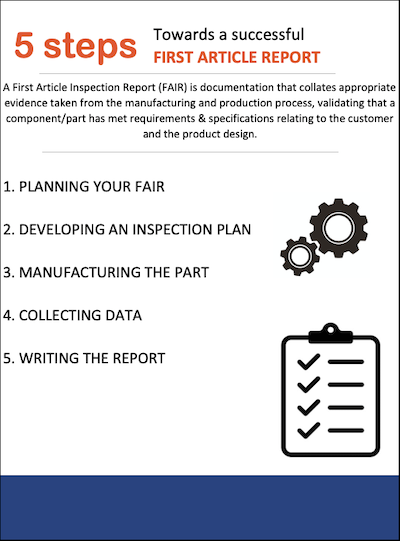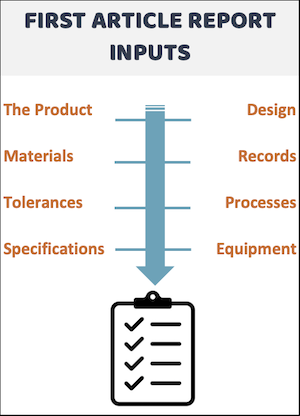
A First Article Inspection Report (FAIR) is documentation that collates appropriate evidence taken from the manufacturing and production process, validating that a component/part has met requirements & specifications relating to the customer and the product design.
First Article Inspection reports are common in the Defence & Aerospace business and are associated with AS9102.
In this article, we’ll be looking at First Article Inspection
We’ll be covering:
- What is a First Article Inspection report?
- Why do we need First Article Reports?
- When should a First Article report be carried out?
- How do I write a First Article Inspection report?
- Planning the First Article Report
- Developing an inspection plan
- Manufacturing the part
- Collecting the data
- Writing the report
- What happens when a part fails the FAI
What is a First Article Inspection Report?
A First Article Inspection Report (FAIR) involves validating a manufactured part to ensure that customer requirements/specifications have been met.
The First Article Inspection report has several characteristics including:
- It is significantly detailed
- It is used to validate products obtained from the first production run.
- The quantity assessed may range from one unit to a small batch
- Items are chosen as a sample (at random)
· By validating the sample(s) to requirements, assumptions can be made that all products within that production meet requirements (and, assuming no production process changes are made, for future runs too).
- Under AS9102, there are three forms
- Form 1 – Identifies the product being examined (this includes the sub-assemblies)
- Form 2 – Product Accountability – details requirements including
- Specifications
- Materials
- Processes
- Tests
- Form 3 – Summarises the design characteristics of the part being subjected to FAI.
When it comes to what to validate, factors such as the following are compared to the specifications
- The design, sizes, and dimensions,
- Materials used
- Processes used against requirements as specified within the drawing pack (i.e., Heat Treatment)
- Equipment used
Information by way of Balloon Drawings that capture the design characteristics are used to evidence the Form 3 identifying the design characteristics, corroborating that it meets requirements.
Further to information about the product being assessed, the FAIR will also contain information around the inspection, such as the
- Part number being assessed,
- The name/position of the reviewer
- The date the review was carried out.
Why do we need a first article report?
Manufacturing parts requires a level of accuracy to specification; if specifications are not met, there could be impacts to performance and safety.
If parts are not verified to ensure that production processes have resulted in a part that meets specifications, then the user could be exposed to issues such as:
- Parts that may not function as expected
- Parts that may not last as long as expected
- Parts that may have critical issues which could impact safety
Without the use of a First Article Inspection report, you may only find out about issues at the point of use (or at worst, after catastrophic failure)
First Articles help
- Ensure that parts are acceptable for use (as they meet specifications)
- Avoid costly delays at the point of use
- Helps identify manufacturing errors
- Have confidence in processes ahead of mass production
- Support customer requirements.
When should a first article inspection be carried out?
FAIR’s are not just limited to first off productions; they are likely to be produced when:
- The parts are manufactured the first time
- Design changes occur
- Production process changes occur
- The location of the manufacturer changes; i.e., they change the factory it is produced in
- The production of the part resumes after a 2-year gap
- Production processes change
- A FAIR is requested by a customer
How do I write a First Article Inspection report?
Rather than tackling your first article as a simple document, you should consider the First Article Report as a process.
There are five steps used to produce a First Article Report.
- Planning the First Article Report
- Developing an inspection plan
- Manufacturing the part
- Collecting the data
- Writing the report
Let’s take a look at these steps in a bit more detail.

1/ Planning your FAIR
Planning is one of the most critical elements of producing a FAIR
If you leave your FAI until after the manufacturing process, you could miss certain aspects or features that you need data to qualify, leaving you unable to produce your report.
Your planning phase is likely to include
- Obtaining Design drawings & bill of materials
- Obtaining specifications
- Reviewing route cards
- Obtaining key supplier inputs (materials and/or third-party services required to complete the parts).
- Drafting the FAIR
Note: much of this task is likely to require you to review artifacts relating to the part so that you can construct your FAIR.
Ensure you allocate sufficient time as this is likely to be time-consuming.
When planning, consider what is the right equipment for capturing data. Make sure that you’re using what’s appropriate and can provide accurate results.
2/ Develop your inspection plan
In this step, consider your inspection plan, what you need to capture, and how. Note that in considering this upfront, you can save time in the long run.
This process is likely to include:
- Identify the requirement to be inspected (likely to consist of balloon drawings with inspection criteria and comments)
- Prepare your AS9102 forms for the inspection.
- Populate the Form 1 and Form 2 with pertinent data from the Bill of material/Specification.
- Document requirements such as:
- Units of measure,
- Tolerances (where applicable)
- Classifications
- Populate the Form 3 with relevant information relating to the inspection.

3/ Manufacturing
During the manufacturing process, you may need to observe or capture/document results against the requirements as required.
4/Collect data
Collect the relevant data required by the FAIR this is likely to include:
- Requirements identified in previous steps
- Certification relevant to the production process (e.g., calibration certificates).
5/ Write the report
Document your FAIR using the appropriate AS9102 forms.
While the method is fairly straightforward, constructing the FAIR can be an intricate process with various complex details to capture and correctly document.
The output of the report phase is the assessment of whether the part produced has met the criteria required.
Mistakes can be made.
Many organizations turn to FAIR software applications to help with the process, improve accuracy and reduce the time of completion.
Whichever method you use, accuracy and detail are required.
What happens when a part fails the FAI
As we’ve discussed, the FAIR takes place in order to validate that the part meets the specifications of the part.
Not all manufacturing results in a part that meets requirements (problems do occur), so what happens when they don’t meet those specifications?
In instances such as these, several things happen
- There is usually an assessment to understand the cause.
- The part could move back into production to address the issues.
Where the FAIR is completed successfully, full production can begin.
Summary
The first article process, whilst following a series of simple steps to construct, can be a complex and time-consuming process.
However, it is a necessary one.
Standards such as AS9102B help define how FAIR is to be constructed. Without their use, parts that do not meet specifications could find their way into use resulting in critical safety or operational issues.
We’d love to know your thoughts on the First Article inspection – perhaps you utilize FAIR software and have some tips or recommendations. Perhaps you work with suppliers in providing FAIR’s evidencing parts have been manufactured correctly.
We’d love your feedback. You can reach us on Twitter (https://twitter.com/qmsgurus) or via the comments section below.
